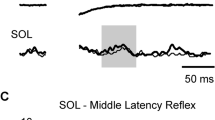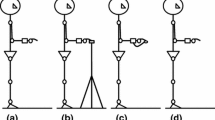Abstract
Availability of fingertip touch onto a stable surface reduces body sway for subjects standing with eyes closed. This is largely associated with sensory feedback from the fingertip when mechanical load is limited. Here, it is possible that the central nervous system facilitates cortical sensory processing to augment feedback to control upright stance. To test this, we compared cortical sensory excitability between tasks with and without light finger touch while standing. Subjects stood in tandem on a force plate with eyes closed while lightly touching a stable surface with the index finger. This was, in two different studies, compared to: (1) no haptic contact or (2) light touch on an object not referenced to balance. Throughout testing, the median nerve was stimulated and electroencephalography was used to measure somatosensory evoked potentials (SEPs). As expected, availability of stable light touch reduced medial–lateral COP sway. Peak amplitudes for SEP components revealed reduced P100 (48%), but increased P50 (31%), N140 (80%), and P200 (20%) during stable touch versus no touch. The modulation of P50 and N140 was no longer present when comparing stable to control (touch), which suggested that attending to touch on either surface, regardless of stability reference, accounted for these changes. Conversely, P200 was increased (19%) when touching the stable surface. Our data show SEP modulation during a standing balance task related to hand contact. Facilitation of P200 in particular may indicate task-specific regulation of the cortical representation of fingertip afferent input when it is relevant to providing stable cues for static balance control.







Similar content being viewed by others
References
Adler J, Giabbiconi CM, Muller MM (2009) Shift of attention to the body location of distracters is mediated by perceptual load in sustained somatosensory attention. Biol Psychol 81:77–85
Albertsen IM, Temprado JJ, Berton E (2010) Effect of haptic supplementation on postural stabilization: a comparison of fixed and mobile support conditions. Hum Mov Sci 29:999–1010
Allison T, McCarthy G, Wood CC, Darcey TM, Spencer DD, Williamson PD (1989) Human cortical potentials evoked by stimulation of the median nerve. I. Cytoarchitectonic areas generating short-latency activity. J Neurophysiol 62:694–710
Allison T, McCarthy G, Wood CC, Jones SJ (1991a) Potentials evoked in human and monkey cerebral cortex by stimulation of the median nerve. A review of scalp and intracranial recordings. Brain 114 (Pt 6):2465–2503
Allison T, Wood CC, McCarthy G, Spencer DD (1991b) Cortical somatosensory evoked potentials. II. Effects of excision of somatosensory or motor cortex in humans and monkeys. J Neurophysiol 66:64–82
Allison T, McCarthy G, Wood CC (1992) The relationship between human long-latency somatosensory evoked potentials recorded from the cortical surface and from the scalp. Electroencephalogr Clin Neurophysiol 84:301–314
Braun C, Haug M, Wiech K, Birbaumer N, Elbert T, Roberts LE (2002) Functional organization of primary somatosensory cortex depends on the focus of attention. Neuroimage 17:1451–1458
Brooke JD, Staines WR, Cheng J, Misiaszek JE (1997) Modulation of cerebral somatosensory evoked potentials arising from tibial and sural nerve stimulation during rhythmic active and passive movements of the human lower limb. Electromyogr Clin Neurophysiol 37:451–461
Chapman CE, Meftah E (2005) Independent controls of attentional influences in primary and secondary somatosensory cortex. J Neurophysiol 94:4094–4107
Day BL, Cole J (2002) Vestibular-evoked postural responses in the absence of somatosensory information. Brain 125:2081–2088
Day BL, Guerraz M, Cole J (2002) Sensory interactions for human balance control revealed by galvanic vestibular stimulation. Adv Exp Med Biol 508:129–137
Desmedt JE, Robertson D (1977) Differential enhancement of early and late components of the cerebral somatosensory evoked potentials during forced-paced cognitive tasks in man. J Physiol 271:761–782
Desmedt JE, Tomberg C (1989) Mapping early somatosensory evoked potentials in selective attention: critical evaluation of control conditions used for titrating by difference the cognitive P30, P40, P100 and N140. Electroencephalogr Clin Neurophysiol 74:321–346
Desmedt JE, Tomberg C (1994) Transient phase-locking of 40 Hz electrical oscillations in prefrontal and parietal human cortex reflects the process of conscious somatic perception. Neurosci Lett 168:126–129
Desmedt JE, Huy NT, Bourguet M (1983) The cognitive P40, N60 and P100 components of somatosensory evoked potentials and the earliest electrical signs of sensory processing in man. Electroencephalogr Clin Neurophysiol 56:272–282
Dowman R (2004) The pain-evoked P2 is not a P3a event-related potential. Brain Topogr 17:3–12
Eimer M, Forster B (2003a) Modulations of early somatosensory ERP components by transient and sustained spatial attention. Exp Brain Res 151:24–31
Eimer M, Forster B (2003b) The spatial distribution of attentional selectivity in touch: evidence from somatosensory ERP components. Clin Neurophysiol 114:1298–1306
Fitzpatrick R, Burke D, Gandevia SC (1994) Task-dependent reflex responses and movement illusions evoked by galvanic vestibular stimulation in standing humans. J Physiol 478(Pt 2):363–372
Fuster JM (2008) The Prefrontal Cortex, 4th edn. Academic Press
Garcia-Larrea L, Lukaszewicz AC, Mauguiere F (1995) Somatosensory responses during selective spatial attention: the N120-to-N140 transition. Psychophysiology 32:526–537
Giabbiconi CM, Trujillo-Barreto NJ, Gruber T, Muller MM (2007) Sustained spatial attention to vibration is mediated in primary somatosensory cortex. Neuroimage 35:255–262
Hamalainen H, Kekoni J, Sams M, Reinikainen K, Naatanen R (1990) Human somatosensory evoked potentials to mechanical pulses and vibration: contributions of SI and SII somatosensory cortices to P50 and P100 components. Electroencephalogr Clin Neurophysiol 75:13–21
Holden M, Ventura J, Lackner JR (1994) Stabilization of posture by precision contact of the index finger. J Vestib Res 4:285–301
Iguchi Y, Hoshi Y, Tanosaki M, Taira M, Hashimoto I (2005) Attention induces reciprocal activity in the human somatosensory cortex enhancing relevant- and suppressing irrelevant inputs from fingers. Clin Neurophysiol 116:1077–1087
Inglis JT, Horak FB, Shupert CL, Jones-Rycewicz C (1994) The importance of somatosensory information in triggering and scaling automatic postural responses in humans. Exp Brain Res 101:159–164
Jacobs JV, Horak FB (2007) Cortical control of postural responses. J Neural Transm 114:1339–1348
Jeka JJ (1997) Light touch contact as a balance aid. Phys Ther 77:476–487
Jeka JJ, Lackner JR (1994) Fingertip contact influences human postural control. Exp Brain Res 100:495–502
Jeka JJ, Lackner JR (1995) The role of haptic cues from rough and slippery surfaces in human postural control. Exp Brain Res 103:267–276
Jeka JJ, Oie KS, Kiemel T (2008) Asymmetric adaptation with functional advantage in human sensorimotor control. Exp Brain Res 191:453–463
Kouzaki M, Masani K (2008) Reduced postural sway during quiet standing by light touch is due to finger tactile feedback but not mechanical support. Exp Brain Res 188:153–158
Krishnamoorthy V, Slijper H, Latash ML (2002) Effects of different types of light touch on postural sway. Exp Brain Res 147:71–79
Lackner JR, Rabin E, DiZio P (2001) Stabilization of posture by precision touch of the index finger with rigid and flexible filaments. Exp Brain Res 139:454–464
Mauguiere F, Merlet I, Forss N, Vanni S, Jousmaki V, Adeleine P, Hari R (1997a) Activation of a distributed somatosensory cortical network in the human brain. A dipole modelling study of magnetic fields evoked by median nerve stimulation. Part I: location and activation timing of SEF sources. Electroencephalogr Clin Neurophysiol 104:281–289
Mauguiere F, Merlet I, Forss N, Vanni S, Jousmaki V, Adeleine P, Hari R (1997b) Activation of a distributed somatosensory cortical network in the human brain: a dipole modelling study of magnetic fields evoked by median nerve stimulation. Part II: effects of stimulus rate, attention and stimulus detection. Electroencephalogr Clin Neurophysiol 104:290–295
Maurer C, Mergner T, Peterka RJ (2006) Multisensory control of human upright stance. Exp Brain Res 171:231–250
Mauritz KH, Dietz V (1980) Characteristics of postural instability induced by ischemic blocking of leg afferents. Exp Brain Res 38:117–119
Mergner T, Maurer C, Peterka RJ (2003) A multisensory posture control model of human upright stance. Prog Brain Res 142:189–201
Michie PT, Bearpark HM, Crawford JM, Glue LC (1987) The effects of spatial selective attention on the somatosensory event-related potential. Psychophysiology 24:449–463
Mochizuki G, Boe S, Marlin A, McIlRoy WE (2010) Perturbation-evoked cortical activity reflects both the context and consequence of postural instability. Neuroscience 170:599–609
Nakata H, Inui K, Wasaka T, Nishihira Y, Kakigi R (2003) Mechanisms of differences in gating effects on short-and long-latency somatosensory evoked potentials relating to movement. Brain Topogr 15:211–222
Nunez A, Malmierca E (2007) Corticofugal modulation of sensory information. Adv Anat Embryol Cell Biol 187:1 p following table of contents, 1–74
Oie KS, Kiemel T, Jeka JJ (2002) Multisensory fusion: simultaneous re-weighting of vision and touch for the control of human posture. Brain Res Cogn Brain Res 14:164–176
Ouchi Y, Okada H, Yoshikawa E, Nobezawa S, Futatsubashi M (1999) Brain activation during maintenance of standing postures in humans. Brain 122(Pt 2):329–338
Pasternak T, Greenlee MW (2005) Working memory in primate sensory systems. Nat Rev Neurosci 6:97–107
Prochazka A (1989) Sensorimotor gain control: a basic strategy of motor systems? Prog Neurobiol 33:281–307
Riley MA, Stoffregen TA, Grocki MJ, Turvey MT (1999) Postural stabilization for the control of touching. Hum Mov Sci 18:795–817
Rogers MW, Wardman DL, Lord SR, Fitzpatrick RC (2001) Passive tactile sensory input improves stability during standing. Exp Brain Res 136:514–522
Romo R, Hernandez A, Zainos A, Lemus L, Brody CD (2002) Neuronal correlates of decision-making in secondary somatosensory cortex. Nat Neurosci 5:1217–1225
Schubert R, Ritter P, Wustenberg T, Preuschhof C, Curio G, Sommer W, Villringer A (2008) Spatial attention related SEP amplitude modulations covary with BOLD signal in S1–a simultaneous EEG–fMRI study. Cereb Cortex 18:2686–2700
Slobounov S, Hallett M, Cao C, Newell K (2008) Modulation of cortical activity as a result of voluntary postural sway direction: an EEG study. Neurosci Lett 442:309–313
Staines WR, Brooke JD, Angerilli PA, McIlroy WE (1998) Generalisability of sensory gating during passive movement of the legs. Brain Res 801:125–129
Staines WR, Brooke JD, McIlroy WE (2000) Task-relevant selective modulation of somatosensory afferent paths from the lower limb. Neuroreport 11:1713–1719
Staines WR, Graham SJ, Black SE, McIlroy WE (2002) Task-relevant modulation of contralateral and ipsilateral primary somatosensory cortex and the role of a prefrontal-cortical sensory gating system. Neuroimage 15:190–199
Stapley PJ, Ting LH, Hulliger M, Macpherson JM (2002) Automatic postural responses are delayed by pyridoxine-induced somatosensory loss. J Neurosci 22:5803–5807
Thompson C, Belanger M, Fung J (2010) Effects of plantar cutaneo-muscular and tendon vibration on posture and balance during quiet and perturbed stance. Hum Mov Sci
Ting LH, Macpherson JM (2004) Ratio of shear to load ground-reaction force may underlie the directional tuning of the automatic postural response to rotation and translation. J Neurophysiol 92:808–823
Vuillerme N, Isableu B, Nougier V (2006) Attentional demands associated with the use of a light fingertip touch for postural control during quiet standing. Exp Brain Res 169:232–236
Woollacott M, Shumway-Cook A (2002) Attention and the control of posture and gait: a review of an emerging area of research. Gait Posture 16:1–14
Acknowledgments
This work was supported by research grants to WRS and WEM from the Natural Sciences and Engineering Research Council of Canada and by funds from the Canada Research Chairs program to WRS. DAEB was supported by postdoctoral fellowships from the Ontario Ministry of Research and Innovation and the Heart and Stroke Foundation Centre for Stroke Recovery. The authors thank Wendell Prime and Jeff Rice for constructing the touch platform used in this study and Jonathan Thacker and Kaitlyn Brown for assistance with data collection.
Author information
Authors and Affiliations
Corresponding author
Additional information
An erratum to this article can be found at http://dx.doi.org/10.1007/s00221-012-3037-4.
Rights and permissions
About this article
Cite this article
Bolton, D.A.E., McIlroy, W.E. & Richard Staines, W. The impact of light fingertip touch on haptic cortical processing during a standing balance task. Exp Brain Res 212, 279–291 (2011). https://doi.org/10.1007/s00221-011-2728-6
Received:
Accepted:
Published:
Issue Date:
DOI: https://doi.org/10.1007/s00221-011-2728-6




